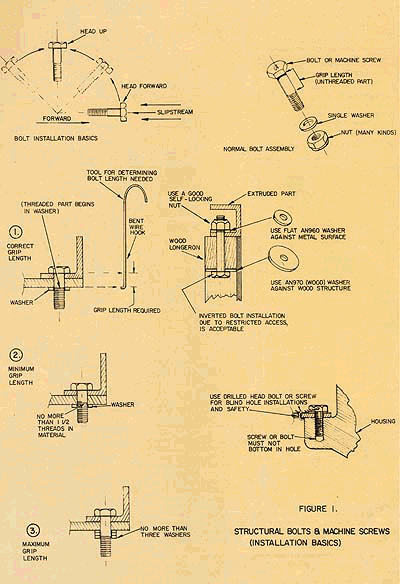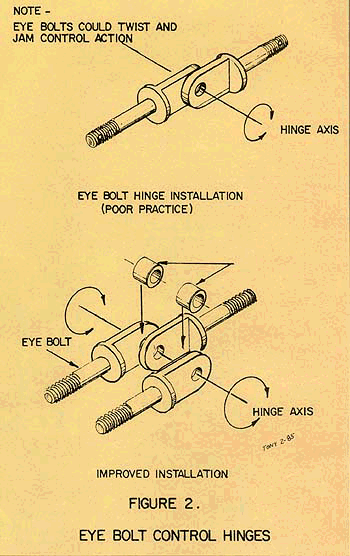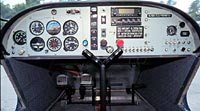
Are You Using Aircraft Hardware Correctly?
Sport Aviation - 6/85
By Tony Bingelis -
It
doesn't take a mental giant to be able to install a bolt in a hole,
slip on a nut and torque (that means 'tighten", Wilbur) it. It does,
however, take a bit of thought, knowledge, self discipline and skill to
do it correctly most of the time, and under different installation
limitations.
For the most
part, I would assume that the folks building and rebuilding warbirds,
racers and space shuttles are the most likely group that would use
aircraft hardware correctly. I am not as sure about the ultralight,
lightplane and other amateur builders as they are as contrasting a
group of individuals as they are innovative. For this reason, if for no
other, I make this plea.
Please
don't even think of putting hardware store nuts and bolts in your
aircraft project, even if they don't look like stove bolts. The
importance of correctly selecting and correctly using the hardware that
will be holding your airplane together deserves your most careful
attention. After all, the safe and efficient operation of your aircraft
will greatly depend on it.
I
am told that the reason some first-time builders use commercial grade
hardware is because nobody told them they shouldn't. Well, consider
yourself told.
It is quite
understandable that a builder who needs a particular sized bolt would
be tempted to substitute anything else that would fit. After all, it is
mighty convenient to be able to dash off to the hardware store and pick
up a few bolts in the correct size just when you need them most.
Unfortunately, they simply will not do. Most hardware store bolts have
less than half the strength of similar sized aircraft bolts. In
addition, they are prone to corrode and weather poorly, even though
they are plated. See the difference for yourself . . . place two bolts
side by side and compare the aircraft bolt to the hardware store bolt.
The aircraft bolt will have a smoother finish and look much better than
the commercial example. You will notice, too, that almost all
commercial bolts have a coarse thread and you can't find self-locking
nuts for them. Of course, there are high quality commercial bolts that
have high tensile strengths and could probably be substituted safely.
Even
the experienced builder sometimes finds himself without the proper
hardware (bolt, etc.). And he, too, may decide to substitute something
else for the missing item. He substitutes the needed bolt deliberately,
but due to his knowledge and experience, the substitution is fairly
safe, or at least acceptable for a particular use. Not so with an
individual who may be a whiz at a podium or among the "software set"
but not so comfortable with things mechanical. He might make an
unacceptable substitution, when faced with the same problem, simply to
get on with his project. Actually, I don't think anyone, regardless of
his background, should make substitutions in important structural
applications without at least checking with the designer.
Even
though it seems that rules are destined to be broken either
deliberately or through blissful unawareness (ignorance, I think it's
called), rules are useful and can even be important. A few written and
unwritten topical rules follow.
As
a rule, a bolt assembly generally consists of a bolt, a single washer
and a nut. You can get by with a single washer provided the bolt length
is correct for that particular location (see Figure 1).

The
washer is always placed under the end that will be torqued. In all
normal installations this would be under the nut. Does that mean that
if you put a washer under the head of the bolt it would be O.K. to
torque it? Well, the unwritten rule says it is bad practice to tighten
a nut by turning the bolt head (it abrades the cadmium plating and
tends to loosen the fit, that's why). Still, there are times when this
is necessary.
I am sure most of you have heard of the rule that the bolt head always goes up or faces forward into the slipstream.
This
concept is based on the notion that if the nut comes off, gravity (or
the slipstream) will hold the bolt in place. Using the same reasoning,
you would put the head of the bolt on the inboard side of a helicopter
rotor head so that centrifugal force would keep it in place.
Nice
thinking there and I'm sure that the "heads up" and "heads forward"
practice is a good one. However, in some installations, it matters
little how the bolt is inserted. If the nut comes off, the assembly
will fall off, period. You should be aware of this. Sometimes it is
absolutely impossible to install a bolt with the head up due to a lack
of access or due to some structural peculiarity. So, install the thing
head-down and don't worry about it. Just make sure that you use a good
self-locking nut, or one that can be safetied in some other manner.
Why
do you suppose aircraft manufacturers have a rule against cutting bolts
or reworking threads without special permission? Since you are the
manufacturer of your airplane what do you think about the practice?
Cutting the end of a bolt off is no monumental thing, at worst the end
would get rusty. Rethreading the shank, however, could be risky if the
bolt were to be used in a highly stressed area or subjected to load
reversals.
There is a rule
about bolt lengths. It says that the bolt should be long enough that no
threads bear on the structure or fitting. Other variations of the rule
say that no more than 1 ½ threads shall bear on the structure or
fitting. Another way of saying essentially the same thing is to say
that the grip length (unthreaded part of the shank) shall equal that of
the parts being connected. At any rate, getting the correct bolt length
is important.
The catalogs
list the various AN (Army/Navy Specification) bolt lengths in 1/8 inch
increments so an AN3-7 bolt would be a 3/16" bolt 7/8" long. Don't
forget that about 3/8" of that bolt are taken up by threads and the
grip length will be considerably shorter than the total length.
Plans
are getting better as the years go by and designers are now doing a
fairly good job of calling out the correct bolt sizes and lengths.
However, you should check each installation to see that the grip length
is correct for your project and that the bolt is not too short. If you
can see the edges of the material being bolted together, or if you know
the total thickness, arriving at the correct bolt length is easy. There
are places, however, where you don't know exactly how long a bolt you
will need unless you try two or three. Here's an easier way.
Make
and use your own grip measuring tool. Bend this handy gadget out of a
piece of 1/16" welding rod, or .040" safety wire, into approximately
the shape shown in Figure 1. Insert the wire in the bolt hole
so that the short hook catches on the back surface. Mark the top
surface level on the wire or simply hold your thumb and fingernail over
that location. Withdraw the wire and measure the grip length that will
be needed.
There Are Nuts And There Are Nuts
I don't know what that means but, you guessed it, there are written and unwritten rules regarding the use of nuts.

It
is said that all nuts, with the exception of safety (self-locking)
nuts, must be locked by cotter pins, safety wire or, if because of
inaccessibility, by painting the end of the bolt and nut. Locking may
also be achieved by peening the end of the bolt when a plain or
castellated nut is used. Sounds kind of primitive (and it is), but it
is effective and the safest thing to do when nothing else can be done.
Fortunately, there are many varieties of nuts and often any one of several kinds of nuts can be used in a specific installation.
One
rule says you should only use high temperature nuts in the engine
compartment. The self-locking high temperature nuts are all-metal and
can withstand temperatures of 450 degrees F and higher. Most of these
nuts obtain their locking capability from threads that are slightly out
of phase with the basic threads. Other types feature a basic nut that
has a portion of it slightly "out of round". Another type has saw cuts
(vertical slots) around its outer end circumference. These are pinched
in to effect the locking feature.
The
self-locking nut that has a fiber/nylon (usually red) insert cannot be
subjected to temperatures above 250 degrees F without causing the
locking feature to deteriorate.
Obviously,
it is all right to use a high temperature type self-locking nut
anywhere in the aircraft . . . even if it doesn't get hot there. Right?
However, you had better keep the fiber insert type of self-locking nut
out of the engine compartment. That is a pretty clear cut rule but if
you knew where the temperatures were moderate enough you could still
use the fiber nut there with confidence, but why waste time running
studies and tests? Use the high temperature type nuts in the engine
compartment and be done with it.
The
same kind of reasoning is applied to shear nuts. You have self-locking
shear nuts and you have castle shear nuts. Both are very thin when
compared to the regular nuts. Shear nuts should never be used for other
than shear applications. Regular self-locking or Castle nuts may be
used for both shear and tension installations. So you can replace that
skinny nut with a fat one but do not use a shear nut where it is
subjected to tension loads.
There
is still another rule that affects the use of self-locking nuts. It
says that you should never ever use a self-locking nut next to a
surface that is subjected to movement (turning, twisting, rotating or
whatever). That movement under a self-locking nut could ultimately
cause it to loosen and fall off. You can, however, use self-locking
nuts any place there is no relative movement between the nut and the
part to which it is attached.
For
example, you can use self-locking nuts in a pulley installation, in a
rod end bearing installation or against an anti-friction bearing where
the nut tightly binds against the inner race of the bearing or against
a part of the fitting that tightly binds the inner race of the bearing. Figure 4 has an example shown.

Ready
for another one? Never run a thread cutting tap through a self-locking
locking nut as this will ruin its self-locking capability. This is
especially applicable to the fiber insert self-locking nuts used with
machine screws.
Often safety
nuts are very difficult to torque onto a machine screw because they
have to be turned with a screw driver. A screw driver cannot deliver
the twisting force possible with a wrench on a hex head bolt. Some
builders solve the difficulty by running a tap through the nut. Wrong,
wrong. Of course, if you only need a nut and the self-locking feature
is unimportant . . . but why not do it right?
Some
people will tell you (more rules) that you shouldn't ever reuse a
self-locking nut. Others say don't reuse one more than twice. (Saw a
manufacturer's claim, somewhere, saying their nut was good enough for
50 reuses!) Pray tell, how would you know how many times it has already
been used? So far, we don't have to keep a Nut Log Book.
My
own rule is simple. Don't reuse any self-locking nut but if you do,
make sure that it will not spin on all the way just using your fingers.
In other words, make sure that the locking resistance of the nut is
still effective. Alas, I just learned that there is an all-metal self
locking nut that can be spun on by hand and the self locking feature
does not engage until it is torqued with a wrench. Now what? I guess
I'll just have to know what kind of nuts I am working with.
Here
is another reminder about self-locking fiber nuts (reminders are sort
of rules, too). Do not make a habit of using a self-locking fiber
insert type of nut on a drilled bolt smaller than 5/16" in diameter. If
you do use a drilled bolt, be sure that there are no burrs around the
cotter pin hole that could tear into the elastic insert. Maybe they
make too much of this rule but then again, who wants to drive around
with slashed tires even if they do hold air?
Let me give you one more and then I'll quit.
Inspectors
and EAA Designees like to point out casually that that bolt is too long
or that this one is too short, simply by looking at the nut. The rule
they go by is one that says, when more than 3 threads are showing
outside the nut the bolt may be too long. If the bolt is too long, the
nut may not even be securing the bolt. (The nut has merely bottomed
against the shank.)
But, wait,
sometimes even one's eyes can be fooled. Some of the newer types of
aerospace nuts appearing on the market are much smaller than the
standard self-locking nuts. Using these can result in many more of the
bolt threads being visible beyond the nut. This gives the erroneous
impression that the bolt is too long.
Just proves that you can't believe everything you see or hear . . . you've got to think, too.
End of Sermon.


